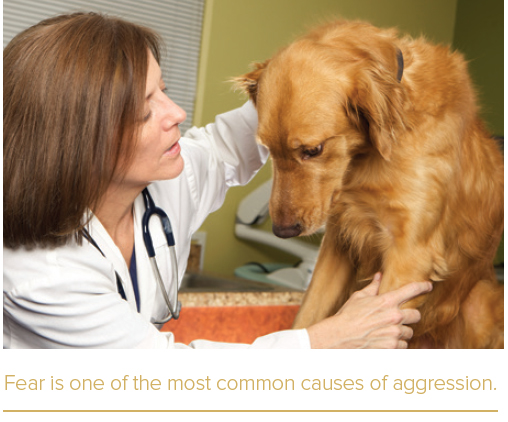Common behavioral problems
Aggression

Aggression occurs any time an animal growls, snarls, snaps, or bites. Fear is one of the most common causes of aggression. Punishment should not be used in aggression cases because it increases the risk of bites and aggravates aggressive behavior. Treatment of the underlying cause is key. That approach usually involves avoidance, protection (of the dog and humans), behavior modification, extra-label medication use [TCAs, SSRIs, and sometimes gabapentin or certain BZDs (e.g., alprazolam)], and various restraint tools such as head
collars and harnesses. Management of unwanted aggression may be lifelong.
Use of a liability release form containing the following disclaimers is recommended in the treatment of aggression:
- Any animal that is aggressive for any reason has the potential to cause serious damage and harm to itself and other pets and people.
- Special precautions must be taken to ensure that everyone is safe when interacting with aggressive dogs. These precautions may include some form of confinement (e.g., gates, crates) or the use of leads, harnesses, head collars, and muzzles.
- Proof of current rabies vaccination should be provided to anyone involved in the treatment of the aggression.
- Treating a behavioral aggression problem is not a substitute for adherence to local laws.
- Owning an aggressive dog or cat carries with it responsibility and potential liability for any damage done to people or property. This responsibility is not changed or transferred by seeking behavioral help.
- Problems involving pathological behaviors, including aggression, are never cured but can be treated and managed. Failure to do so may lead to euthanasia of the animal.
Elimination disorders
Elimination disorders in cats are typified by elimination outside of a preferred area. Diagnostic indicators include urine marking (which can also be a normal behavior) and toileting outside of the litter box. Prior to implementing behavioral treatment, treatment of any underlying medical conditions that may be contributing to the problem is essential.
Environmental changes are the first line of treatment and are often effective. Examples include providing extra litter boxes, cleaning litter boxes more often, and changing litter type/litter box style to improve access. 45 Behavioral treatments can also have positive effects on animals treated for primary medical disorders because medical and behavioral conditions can exist concurrently and exacerbate each other.
Separation anxiety
Separation anxiety can occur when a pet is either left home alone or separated from its owner. Separation anxiety usually presents as signs of clinical distress such as pacing, panting, vocalizing, urination, destruction of property, and salivation. This condition should be considered to be a behavioral emergency. Medications, including clomipramine and fluoxetine, have both been approved for use in dogs and should be used as a first-line treatment at the earliest sign of clinical distress. A comprehensive treatment plan includes behavior modification, environmental enrichment, and minimizing separation to the extent possible. Signs of separation anxiety may not be apparent to the owner. This Task Force encourages all clients to annually videotape their pet when they are not home as a way to detect behavioral abnormalities, including less obvious forms of separation anxiety. Medications have a higher likelihood of treatment success if they are used early in the development of observed anxiety. Duration of treatment depends on severity of the anxiety and response to treatment.
Noise phobia
Noise phobia during thunder, fireworks, or storms is a profound fear manifested by hiding, trembling, destruction of property, salivation, or panting. Those behaviors occur in response to a specific sound or circumstances associated with that sound. Anxiolytic medications (e.g., alprazolam and clonazepam for dogs and oxazepam for cats) are used on an as-needed basis as the first line of treatment and
should be given 1–2 hr before an anticipated triggering event. 14 Some patients may also need daily medication, and every one should have concurrent nonpharmacologic management for long-term treatment. 46 Other anxiety diagnoses often coexist with noise phobia. Screening for potential comorbidities is important because comorbidity worsens each condition. 15
Cat-to-cat aggression
Cat-to-cat aggression is evidenced by behaviors such as staring, hissing, swatting, scratching, growling, or biting other cats in the home environment. Treatment plans include medication (generally start with fluoxetine), environmental enrichment, training, play therapy, and safety tools. Regardless of the underlying cause for inter-cat aggression, a critical step in treatment involves separating the cats until a course of medication and behavior modification has been completed. The cats may then be gradually reintroduced. Cases of aggression within a cat’s social group can take anywhere from 2 to 12 mo to resolve, requiring patience. Permanent separation of cats is always an option.



